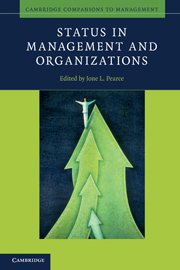Book contents
- Frontmatter
- Contents
- Figures
- Tables
- Contributors
- Foreword
- Preface
- 1 Introduction: The power of status
- Part I How status differences are legitimated
- Part II The influence of status on markets
- Part III The role of status in new industries and ventures
- 6 The cultural context of status
- 7 Venture launch and growth as a status-building process
- Part IV When ascriptive status trumps achieved status in teams
- Part V Status in the workplace
- Part VI Developing status and management knowledge
- Index
- References
6 - The cultural context of status
Generating important knowledge in nanotechnology
from Part III - The role of status in new industries and ventures
Published online by Cambridge University Press: 05 June 2012
- Frontmatter
- Contents
- Figures
- Tables
- Contributors
- Foreword
- Preface
- 1 Introduction: The power of status
- Part I How status differences are legitimated
- Part II The influence of status on markets
- Part III The role of status in new industries and ventures
- 6 The cultural context of status
- 7 Venture launch and growth as a status-building process
- Part IV When ascriptive status trumps achieved status in teams
- Part V Status in the workplace
- Part VI Developing status and management knowledge
- Index
- References
Summary
Status is an important concept that is invoked widely across the social sciences. One common definitional starting point emphasizes how status enables an “effective claim to social esteem in terms of positive or negative privileges” (Weber, 1978, p. 305). In this way, status distributes esteem, deference, honor, and prestige within a social collective (Berger, Cohen, and Zelditch, 1972; Ridgeway, 1991) and, as such, stratifies its members (Knoke and Burt, 1983; Lounsbury, 2002; Podolny, 1993). Because status tracks closely with influence, prominent actors often have the ability to shape the development of fields and markets to their advantage (Fligstein, 1996, 2000) and challenge extant arrangements without facing the harsh penalties levied on other change agents (Greenwood and Suddaby, 2006; Lounsbury, 2007; Merton, 1968; Rao, Monin, and Durand, 2003). Prominent actors also receive more acclaim for performing the same practices than their low-status alters (Benjamin and Podolny, 1999; Merton, 1968). Moreover, high-status actors tend to be targets of imitation, with the result that their practices become widely adopted and highly valued (Haunschild and Miner, 1997; Kraatz and Zajac, 1996).
However, while extant literature has highlighted the many benefits related to high status, much less attention has been paid to the conditions, especially those related to cultural context, under which such benefits are realized. For instance, it is typically assumed that the value of a particular practice tracks closely with the status of its most prominent advocates. This is reinforced by the empirical emphasis on relatively settled fields where culture, status, and practice are well aligned and mutually constitutive (e.g., Bourdieu, 1984; Podolny, 1993). In addition, studies of institutional change suggest that the deference given to high-status actors allows them to foment and valorize new practices relatively unproblematically (e.g., Fligstein, 1996, 2001; Greenwood, Suddaby, and Hinings, 2002; Rao et al., 2003). The resulting imagery is of culture as uniformly beneficial to prominent actors or something which they can act upon to their advantage. But this is not always the case, since marginal actors can also catalyze and facilitate the spread of novel practices and facilitate institutional change (e.g., Leblebici et al., 1991).
- Type
- Chapter
- Information
- Status in Management and Organizations , pp. 155 - 190Publisher: Cambridge University PressPrint publication year: 2010
References
- 2
- Cited by



